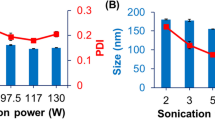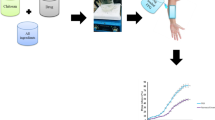Abstract
Diethylenetriamine pentaacetic acid penta-ethyl ester, designated as C2E5, was successfully incorporated into a nonaqueous gel for transdermal delivery. The thermal and rheological properties of a formulation containing 40% C2E5, 20% ethyl cellulose, and 40% Miglyol 840® prepared using the solvent evaporation method demonstrated that the gel had acceptable content uniformity and flow properties. In vitro studies showed that C2E5 was steadily released from the gel at a rate suitable for transdermal delivery. Topical application of the gel at a 200 mg C2E5/kg dose level in rats achieved significantly higher plasma exposures of several active metabolites compared with neat C2E5 oil at the same dose level. The results suggest that transdermal delivery of a chelator prodrug is an effective radionuclide decorporation strategy by delivering chelators to the circulation with a pharmacokinetic profile that is more consistent with the biokinetic profile of transuranic elements in contaminated individuals.





Similar content being viewed by others
REFERENCES
Howard WL, Wilson D. Chelating agents. Kirk–Othmer Encyclopedia of Chemical Technology. New York:Wiley; 2000.
Taylor DM, Stradling GN, Hengé-Napoli M-H. The scientific background to decorporation. Radiat Prot Dosim. 2000;87(1):11–8.
Taylor DM, Volf V. Oral chelation treatment of injected 241Am or 239Pu in rats. Heal Phys. 1980;38(2):147–58.
Volf V. Effect of drinking Zn-DTPA on 238-Pu and 241-Am in rat bones. Radiat Environ Biophys. 1984;23(2):141–3.
Stradling GN, Gray SA, Ellender M, Pearce M, Wilson I, Moody JC, et al. Removal of inhaled plutonium and americium from the rat by administration of ZnDTPA in drinking water. Hum Exp Toxicol. 1993;12(3):233–9. Comparative Study.
FDA approves drugs to treat internal contamination from radioactive elements (2004) http://www.fda.gov/NewsEvents/Newsroom/PressAnnouncements/2004/ucm108339.htm. Accessed 30 May 2012.
National Council on Radiation Protection and Measurements; National Council on Radiation Protection and Measurements. Scientific Committee 57–17 on Radionuclide Dosimetry Model for Wounds. Development of a biokinetic model for radionuclide-contaminated wounds and procedures for their assessment, dosimetry, and treatment: recommendations of the National Council on Radiation Protection and Measurements, December 14, 2006. Bethesda: National Council on Radiation Protection and Measurements; 2007. pp. 35–117.
Crawley FE, Haines JW. The dosimetry of carbon-14 labelled compounds: the metabolism of diethylenetriamine pentaacetic acid (DTPA) in the rat. Int J Nucl Med Biol. 1979;6(1):9–15.
Phan G, Herbet A, Cholet S, Benech H, Deverre JR, Fattal E. Pharmacokinetics of DTPA entrapped in conventional and long-circulating liposomes of different size for plutonium decorporation. J Control Release. 2005;110(1):177–88.
Brown L, Langer R. Transdermal delivery of drugs. Annu Rev Med. 1988;39(1):221–9.
Sloan KB. Prodrugs: topical and ocular drug delivery. New York: Marcel Dekker; 1992.
Chien YW. Novel drug delivery systems. 2nd ed. New York: Marcel Dekker; 1992.
Walters KA. Dermatological and transdermal formulations: London: Informa HealthCare; 2002.
Diethylenetriaminepentaacetic acid (DTPA) Material safety data sheet. www.sigmaaldrich.com, Version 4.8. Accessed 30 May 2012.
Cassatt DR, Kaminski JM, Hatchett RJ, DiCarlo AL, Benjamin JM, Maidment BW. Medical countermeasures against nuclear threats: radionuclide decorporation agents. Radiat Res. 2008;170(4):540–8.
Jay M, Mumper RJ. Methods and pharmaceutical compositions for decorporation of radioactive compounds. United States Patent 8,030,358; 2011.
Sueda K, Sadgrove MP, Fitzsimmons JM, Jay M. Physicochemical characterization of a prodrug of a radionuclide decorporation agent for oral delivery. J Pharm Sci. 2012;101(8):2844–53.
Langner M, Maibach H. Many common drugs in dermatology are light, temperature, or moisture-sensitive. Skin Therapy Lett. 2009;14(1):3–5.
Crowley P, Martini LG. Drug–excipient interactions. Pharm Technol Eur. 2001;13(3):26–34.
Claramonte M, Parera Vialard A, Vilchez FG. In vitro percutaneous absorption of naproxen from gels using a double-layer artificial membrane. Int J Pharm. 1993;98(1–3):37–43.
Lee C, Kitagawa K, Uchida T, Kim N, Goto S. Transdermal delivery of theophylline using an ethanol/panasate 800-ethylcellulose gel preparation. Biol Pharm Bull. 1995;18(1):176.
Lizaso E, Muñoz ME, Santamaría A. Formation of gels in ethylcellulose solutions. an interpretation from dynamic viscoelastic results. Macromolecules. 1999;32(6):1883–9.
Heng PWS, Chan LW, Chow KT. Development of novel nonaqueous ethylcellulose gel matrices: rheological and mechanical characterization. Pharm Res. 2005;22(4):676–84.
Chow K, Chan L, Heng P. Formulation of hydrophilic non-aqueous gel: drug stability in different solvents and rheological behavior of gel matrices. Pharm Res. 2008;25(1):207–17.
Chan L, Chow K, Heng PWS. Investigation of wetting behavior of nonaqueous ethylcellulose gel matrices using dynamic contact angle. Pharm Res. 2006;23(2):408–21.
Chow KT, Chan LW, Heng PWS. Characterization of spreadability of nonaqueous ethylcellulose gel matrices using dynamic contact angle. J Pharm Sci. 2008;97(8):3467–82.
Macosko CW. Rheology: principles, measurements, and applications. New York: VCH; 1994. p. 65–108.
Higuchi T. Physical chemical analysis of percutaneous absorption process from creams and ointments. J Soc Cosmet Chem. 1960;11(2):85–97.
Higuchi W. Analysis of data on the medicament release from ointments. J Pharm Sci. 1962;51(8):802–4.
Rekhi GS, Jambhekar SS. Ethylcellulose—a polymer review. Drug Dev Ind Pharm. 1995;21(1):61–77.
Chang JY, Oh YK, Choi HG, Kim YB, Kim CK. Rheological evaluation of thermosensitive and mucoadhesive vaginal gels in physiological conditions. Int J Pharm. 2002;241(1):155–63.
Pena LE, Lee BL, Stearns JF. Structural rheology of a model ointment. Pharm Res. 1994;11(6):875–81.
Contreras MD, Sanchez R. Application of a factorial design to the study of the flow behavior, spreadability and transparency of a Carbopol ETD 2020 gel. Part II. Int J Pharm. 2002;234(1–2):149–57.
Zhang Y, Sadgrove M, Jay M. Transdermal delivery of DTPA prodrug for continuous decorporation of transuranic elements. Abstract T2248. AAPS Annual Meeting and Exposition, Washington, October, 2011. http://www.aapsj.org/abstracts/AM_2011/T2248.pdf.
Yang Y-T, Di Pasqua AJ, He W, Tsai T, Sueda K, Zhang Y, et al. Preparation of alginate beads containing a prodrug of diethylenetriaminepentaacetic acid. Carbohydrate Polymers. 2012;92:1915–1920. doi:10.1016/j.carbpol.2012.11.071.
Banker GS. Film coating theory and practice. J Pharm Sci. 1966;55(1):81–9.
Bodmeier R, McGinity JW. The preparation and evaluation of drug-containing poly (dl-lactide) microspheres formed by the solvent evaporation method. Pharm Res. 1987;4(6):465–71.
Leuner C, Dressman J. Improving drug solubility for oral delivery using solid dispersions. Eur J Pharm Biopharm. 2000;50(1):47–60.
Lachenmeier DW. Safety evaluation of topical applications of ethanol on the skin and the oral cavity. J Occup Med Toxicol. 2008;3:26.
Barry BW. Dermatological formulations: percutaneous absorption. New York: Marcel Dekker; 1983. pp. 296–440.
Shah VP, Elkins J, Hanus J, Noorizadeh C, Skelly JP. In vitro release of hydrocortisone from topical preparations and automated procedure. Pharm Res. 1991;8(1):55–9.
Shah VP. In vitro release from semisolid dosage forms? What is its value? Percutaneous absorption. London: Informa Healthcare; 2005. pp. 481–8.
Pharmacopoeia E. 2002 European Pharmacopoeia. 4th ed. Strasbourg: Council of Europe; 2002.
Zhang Y, Yang Y-T, Jay M. Species-dependent metabolism of a DTPA prodrug by skin esterases. Abstract T2424. AAPS Annual Meeting and Exposition, Washington, October, 2011. http://www.aapsj.org/abstracts/AM_2011/T2424.pdf.
Pacyniak E, M. Leed, M. Sadgrove, Jay M. Interspecies differences in metabolism of a multi-ester prodrug by carboxylesterases. Abstract W4419. AAPS Annual Meeting and Exposition. Washington, October, 2011. http://www.aapsj.org/abstracts/AM_2011/W4419.pdf.
Morss LR, Edelstein NM, Fuger J, Katz JJ. The chemistry of the actinide and transactinide elements, vol. 2. 3rd ed. Dordrecht: Springer; 2006. p. 1265–395.
Sherry AD, Cacheris WP, Kuan KT. Stability constants for Gd3+ binding to model DTPA-conjugates and DTPA-proteins: implications for their use as magnetic resonance contrast agents. Magn Reson Med. 1988;8(2):180–90.
Shutt A, Youngman M, Raine C, Stradling G, Etherington G, Kreyling W. A study of the human biokinetics of inhaled gadolinium oxide. Ann Occup Hyg. 2002;46 suppl 1:320–2.
Schulz WW. Chemistry of Americium. Richland: Atlantic Richfield Hanford; 1976.
Sadgrove MP, Leed MGD, Shapariya S, Madhura DB, Jay M. Evaluation of a DTPA prodrug, C2E5 as an orally bioavailable radionuclide decorporation agent. Drug Dev Res. 2012;73(5):243–51.
ACKNOWLEDGMENTS
The authors thank Dr. Richard Superfine and UNC Center for Computer Integrated Systems for Microscopy and Manipulation at UNC-Chapel Hill for access to the rheometer, which was funded by NIBIB/NIH award number P41-EB002025, and Dr. Joseph DeSimone for access to the differential scanning calorimeter. The authors also thank Mrs. Shraddha Shapariya for her help with pharmacokinetic studies, Dr. Jeremy Cribb for his help with the rheometer measurements, and Ms. Sara White for help with the differential scanning calorimeter. This work was funded in part by the National Institute of Health, US Department of Health and Human Services under contract HHSN266200500045C.
Author information
Authors and Affiliations
Corresponding author
Rights and permissions
About this article
Cite this article
Zhang, Y., Sadgrove, M.P., Sueda, K. et al. Nonaqueous Gel for the Transdermal Delivery of a DTPA Penta-ethyl Ester Prodrug. AAPS J 15, 523–532 (2013). https://doi.org/10.1208/s12248-013-9459-5
Received:
Accepted:
Published:
Issue Date:
DOI: https://doi.org/10.1208/s12248-013-9459-5




